Winter’s tough enough without denying yourself the pleasure of catching fish. If you live in a place where the mercury dips below zero this time of year, and you’re not exploring ice fishing, you’re missing out.
No, it’s not my favorite discipline, but ice fishing can be surprisingly productive. And, if you like to harvest the occasional trout (or pike, or walleye, or perch), winter is the best time to do it, particularly in lakes and ponds that are full of holdover fish from late plantings (assuming the lake you fish is stocked). This time of year, fish are still eating, but their metabolisms are slower. They eat less — just enough to survive, really. Their flesh is firm and fresh. And, truth be told, nothing tastes better than trout or walleye pulled through a hole in the ice.
For me, it’s the time of year when I can dependably access big fish — here in eastern Idaho and western Wyoming, fishing through the ice gives us avid fly anglers a very real shot at non-native lake trout that are measured in pounds, not inches. These are fish that are infrequently available to us because they are deepwater dwellers that only come into shallower water right around ice-out and again in the fall to spawn. Dropping a baited hook 50, 60 or even 100 feet down into the bowels of a lake or a reservoir puts you within reach of some real trophy fish.
Ice fishing is also an excellent social activity. When I fly fish, I’m happiest when I’m alone, stalking trout on backcountry streams or wandering some tropical flat as I hunt for tails. But when I’m ice fishing, I'm rarely alone. Sure, there are safety concerns that make it smart to fish with a buddy or two, but also … well… misery loves company. If I’m going to sit on a bucket atop a frozen body of water, I’d just as soon have somebody there to share my whiskey and bitch to about how cold I am.
And don’t clutch your pearls, fly-fishing purists. Us long-rodders can easily justify this largely consumptive pursuit. First, many lakes accessible in the winter are managed for put-and-take fishing. And, in some lakes, as I mentioned above, the chance to catch and kill invasive species like lake trout makes the activity more appealing. In truth, fishing through the ice is a time-honored pursuit, and in some states in the Upper Midwest and throughout Canada, ice fishing is a sacred family activity.
And, yes, you can tie “ice flies,” and yes, they can and do work very well. They are particularly useful on lakes that don’t allow bait and require barbless hooks (there are often rules for ice fishing, too — be sure you know them before you drill a hole and drop a line). Ice flies can range from anything from a weighted San Juan Worm to the infamous “blob” flies tied with bright cactus chenille.
Where I live in eastern Idaho, we have some solid choices for ice fishing, and we can catch anything from perch and panfish to trout, kokanee salmon and even smallmouth bass.
The basics
Don’t fret. Unless you’re planning some elaborate ice shanty on skids complete with a generator, a TV and a wet bar, getting started won’t break the bank. You can honestly start ice fishing with a diminutive $30 ice-fishing rod, a 5-gallon bucket and very basic terminal tackle — think a pack of snelled Eagle Claw size 12 bait hooks and some easy pinch-on sinkers (lead-free is best, obviously). Bait can range from mealworms to red worms or, for bigger fish like pike and lake trout, cutbait, like hunks of sucker meat work well. Believe it or not, raw hot dogs are winners on the ice, as are hooks baited with canned corn or old-school salmon eggs. Again, know the regulations on the lake or pond you choose to fish.
Slightly fancier set-ups include rod-holders and tip-ups and even hook-setters that make it easier to have more than one rod going simultaneously over a number of holes drilled into the ice. Again, make sure it’s legal to use multiple rods on the water body you pick.
This brings us to ice augers. Hand augers are affordable — generally around $40 to $50. Unless you’re drilling through feet of ice — some folks do, believe it or not — these handy drills work great. If you must have an auger with a motor, count on spending more than $200, and count on having to maintain it. Some are simple and will last years. Others … not so much.
Other ancillary items for a day on the ice include little scoops — usually perforated plastic — to keep the open holes free of ice. You’ll also need good, warm clothes to beat back the elements. You’ll definitely need gloves and you should consider some reactive hand warmers that can go in your gloves and in your wool socks. Please remember one of the elementary rules to ice fishing — don’t wear cotton. It’s absorbent, gets heavy quickly and takes forever to dry. Should you fall through the ice — unlikely if the ice is more than two or three inches thick — you’ll need to be able to shed clothes quickly to get warm and ward off hypothermia.
Which brings us to ice fishing that’s a bit more … comfortable.
Next-level stuff
I use a portable ice shanty — I purchased it some time ago for under $200, and it goes together a lot like a small tent, with flexible poles that push together to make a secure frame and anchors that secure the structure to the ice — it literally sets up (and breaks down) in minutes. Some don’t even have exposed poles — they simply pop up. The material is a thick and tightly woven fabric and blocks outside light from entering the structure. Good portable shanties also keep out the wind and snow.
Some may think this is overkill, but if I’m out to catch my limit for the smoker, I enjoy a distinct advantage with a portable shanty. How so? The only light that enters the structure actually comes from under the ice — at first, it’s a bit eerie, but you get used to it. And, on clearwater lakes, you can see well into the lake just by looking down through the hole in the ice — visibility can be 20 feet or more in some lakes, meaning you can, at times, see fish approach and take your bait, fly or lure.
I also prefer a cozy camp chair to sitting on an overturned bucket, and, on long days spent on the ice, I’ve been known to drag a portable (and indoor-safe) propane heater into the shanty with me. Honestly, you get two or three guys in there, and it warms up pretty well on its own. Being out of the elements has its advantages.
Where to start?
Not sure where to begin? The easiest way to find productive ice-fishing lakes is to consult your state’s fishing regulations. Most will include the rules associated with ice fishing on particular bodies of water, including allowable harvest, bait rules and the like. If a lake is listed in the regulations, chances are it’s worth a visit.
Once you get to the lake, where do you drill? If you have a depth finder, they’ll often work under the ice — drill a hole and gauge the depth. Generally, depending on subsurface structure, deeper water is preferred (but not always). Some folks go so far as to drop underwater cameras alongside their bait, fly or lure so they can see fish when they approach. This is a bit much for a first-time outing, but if you get into it, it might be something to consider.
For me, when I approach a lake for the first time, I tend to gravitate to areas on the lake where others have drilled holes before me. No, it’s not foolproof, but finding a concentration of holes that are refrozen is a pretty good way to find where other anglers have had success.
That’s about it. If you’ve been ice-curious for a while just poke your head outside. It’s cold out there, folks. You can hibernate. Or you can go catch some fish.





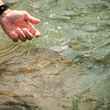






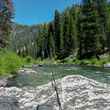



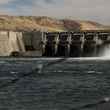
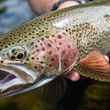



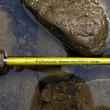
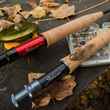



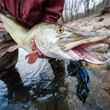



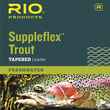
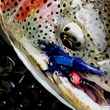
Comments